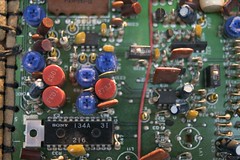
‘Circuit Board Art’
courtesy of ‘tbridge’
The Post is reporting this morning that the trackside train proximity sensors did not function properly on Monday, or in a test on Thursday. These sensors are designed to detect where the trains are in the system and provide that information to other nearby trains to slow or stop them based on proximity.
Metro has undertaken a complete review of all the electronic relays on the Red Line, and will keep the system operating on manual with a maximum speed of 35mph until the review is complete, which may take a few weeks. We’re going to be on manual for a while, so that means adjusting where you’re standing on the platform, as trains are going to be pulling forward to the 8-car mark even at 6 cars long. In addition, Metro will be moving all of the 1000-series cars to the center of trains for safety purposes. If you see a 1000-series car at the front of a train, mark down its car number, time of day and where you saw it, and put it in the comments here? We’ll make sure Metro knows about it.



Aside from looking 35 years old, how does one distinguish between a 1000 series car and a 2000 series?
At the edges of each car is a 4 digit number; the first number indicates what series it is. So 1xxx would be a 1000-series car, and so on.
The 1000-series Rohr cars were completely rebuilt with new components and motors between 13 and 16 years ago by Breda. Stop calling them “35 years old”, they really are not. Also, do not lull yourself into thinking that the later series cars would behave much differently in a crash.
The NTSB would appear to disagree with you, Erik, and the issue at hand is one of structural solidity and a tendency to collapse significantly in a collision. Replacing motors and components does nothing to address how the superstructure is going to handle excessive stresses.
Is redundancy built into these detector systems, and if not, why not?
I’m not sure, Larry. I’d have to think there’s some sort of redundancy built-in, but I suspect a lot of the backup features have to do with the human train operator. In this case, that wasn’t enough.
First let me offer my prayers and condolences to the souls affected by this accident.
Track circuits are not redundant because redundancy does not equal safety. Track circuits are designed to be fail-safe, if anything bad occurs the system should not permit the vehicle to move. Fail-safe systems are prone to failure and shifts in calibration which is why most manufacturers and the FRA require periodic maintenance and performance checks. Redundancy can make a system more reliable but it won’t improve safety unless the redundant systems fail-safe and dissimilar.
This accident appears to have been caused by a track circuit that failed to detect a train occupying a block. When this happens the approaching trains will be commanded at full speed as if there is no train ahead. A worse case failure scenario. How can this possibly happen?
Vehicles do not shunt the rails perfectly and some of the detection signal can leak past the axles and go to the receiver. If this leakage is too high the receiver will not properly detect a train, hence calibration and maintenance of track signals is very important.
http://en.wikipedia.org/wiki/Track_circuit
Car 1120 to Fort Totten, at Gallery Place at 1:14pm today. It was the last car in the train.